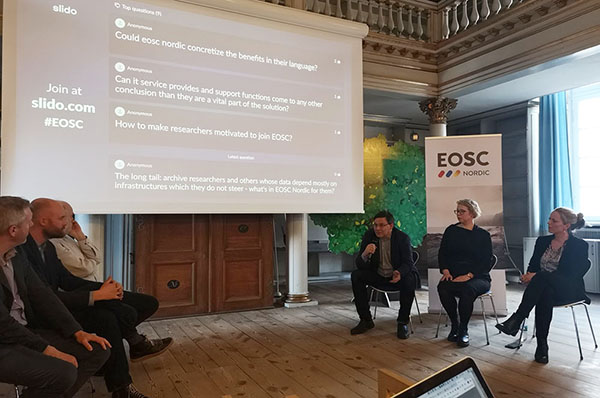Highlights of the Nordic policy workshop panel discussion
EOSC-Nordic – Added Value, Challenges, and Opportunities
On February 6th about 60 EOSC-Nordic stakeholders and partners gathered at the Danish National Archive in Copenhagen for a workshop on the Nordic open science policies. For more information on the program and to view the presentations please visit our news article about the event. The event was co-hosted by the EOSC-Nordic and OpenAIRE. The afternoon culminated in a panel discussion on the challenges and opportunities of EOSC, chaired by Troels Rasmussen, Open Science Cloud Coordinator at DeiC.

Engaging researchers
The first question focused on the difficulty of engaging researchers. This discussion topic closed with the agreement that the benefits of openness should be described in the researchers’ language. Everyone acknowledged the fact that the researchers do have to follow the institutional rules with rankings and other requirements for their career development. Instead of publication driven career incentives, data sharing credits benefitting scientist’s career development should be established. A concrete solution suggestion was that publishing datasets would be a part of the researcher’s CV.
How to keep pace and good role division with the commercial market? The next discussion topic highlighted the need to keep pace with the commercial market, paying attention to quality rather than quantity, as well as good support and training were all deemed as very important factors. It was also mentioned that the universities are very interested in knowing which data is created in universities, so the incentive factor can be used in this instance as well.
Cross-border collaboration on data
Next, the discussion moved to the cross-border collaboration of data, its focus areas and challenges to establish such collaboration. In this instance, Elixir infrastructure for life science data was mentioned as an example. The panelists felt it was important to be careful not to create new communities in addition to the already existing ones, such as ESFRIs, and other communities working together.
There is a need for simple frameworks based on easily applicable principles. There is still a huge challenge to have service providers, research networks and researchers break down data silos for machine readability.
How to pick-up the low hanging fruits, was one question to which the suggested way to proceed was “We should keep the focus on new projects and new data.” as well as “Regarding the sensitive data we have to use the project framework to demonstrate a few scenarios. We do not solve THE problem, but we suggest examples”.
Establishing seamless access to resources across borders
When it comes to establishing seamless access to resources across borders, the panelists acknowledged that excellent projects are going on already, for example, the Dellinger project. So we do have good existing examples already. Adding to this, as there are ESFRIs with established cross-border access, this is entirely possible for others as well.
Access to limited resources (HPC, Storage, Support) – how and why?
When discussing access to limited resources, the Nordic values of “equal, democratic and sharing” came up as values helping to define the access policies. The conclusion was that we should make the resources useable with as little extra as possible so that researchers find them worthwhile to use.
The final question centered on supporting the development of EOSC as a whole and how to get the vision into the policymakers’ minds as well as making sure we do not have too few resources on the development.
“There are multiple visions to be discussed, we should talk about different things and contribute the European EOSC in various relations.” Damien LeCarpentier, CSC.
“We believe that putting people with the right competence in relevant working groups, is an important success factor in the work ahead. In Norway, we have appointed people with hands-on experience to support the different groups in the EOSC. Another success factor in our mind is to involve the research communities more in the current discussions. In future workshops we should also invite researchers.” Siri Lader Bruhn, Research Council of Norway.
Panelist Monica Lassi’s advice was to ask researchers about their frustrations, what works well, and even more importantly, what are the obstacles.
The overwhelming response from the panel and audience alike was that an EOSC that is useful and requested by researchers will get the attention of policymakers and funders, and give the researchers what they need. So we need to make EOSC useful! What do you think about that?